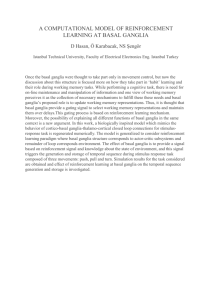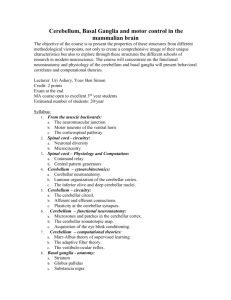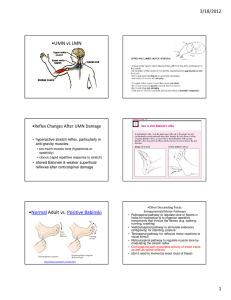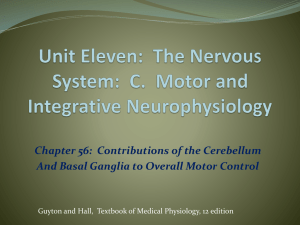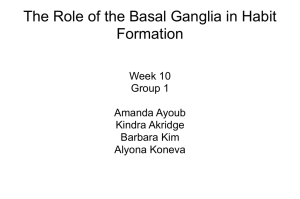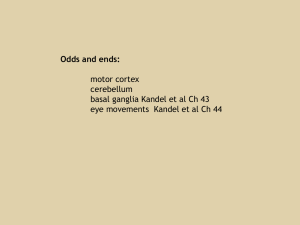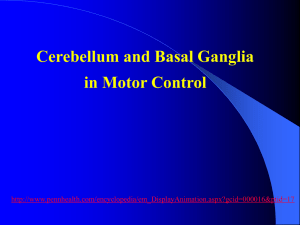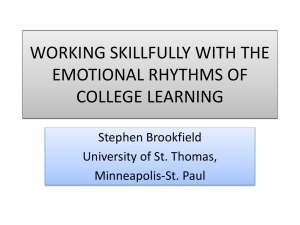Cerebellum and Basal Ganglia
advertisement
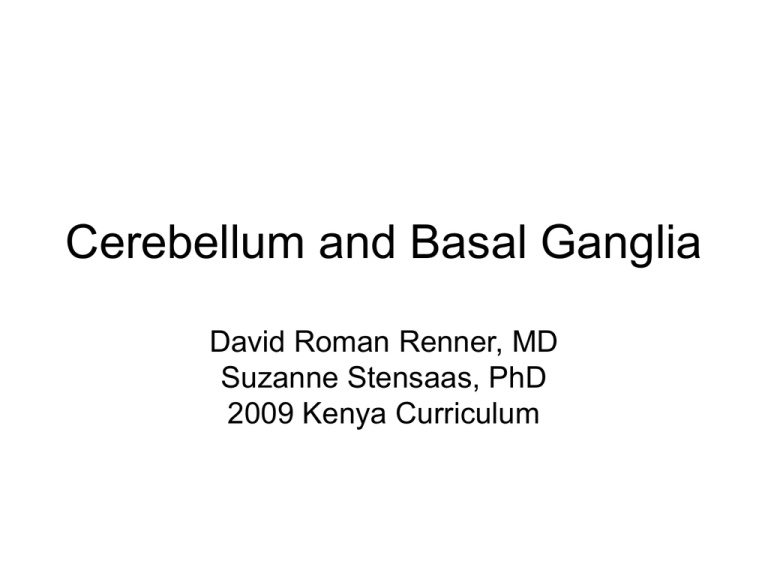
Cerebellum and Basal Ganglia David Roman Renner, MD Suzanne Stensaas, PhD 2009 Kenya Curriculum BG CBLM Courtesy of Stephen C. Voron, MD BG CBLM Courtesy of Stephen C. Voron, MD pyramidal cell in the motor homunculus of the frontal lobe BG CBLM Courtesy of Stephen C. Voron, MD corticospinal tract BG CBLM Courtesy of Stephen C. Voron, MD BG CBLM decusation at the pyramids (spinomedullary junction Courtesy of Stephen C. Voron, MD BG thalamus: AKA the “gate keeper” prevents unwanted movements T CBLM Courtesy of Stephen C. Voron, MD BASAL GANGLIA BG consultant on automatic movements T CBLM Courtesy of Stephen C. Voron, MD provides input into the thalamus Cerebellum: consultant on rapid movements BG CBLM Courtesy of Stephen C. Voron, MD provides input into the thalamus Basal Ganglia Cerebellum • • • • • • • • • • • • • • • • • • • • • • • resting tremor postural instability festination rigidity masked facies bradykinesia dyskinesia torticollis chorea athetosis hemiballismus akathisia intention tremor dysmetria dysdiadochokinesia hypotonia heal to shin finger to nose rebound ataxic gait titubation nystagmus dysmetric saccades Basal ganglia lesions produce contralateral signs. Cerebellar lesions produce ipsilateral signs. Most movement disorders produced by cerebellar and basal ganglia pathology disappear during sleep. Cerebellar and basal ganglia signs are usually not present if the corticospinal tract is damaged. The cerebellum is the great comparator: 1. It compares cortical willful command with muscle tension, joint position, & tone (via ipsilateral spinocerebellar tracts) 2. Advises the cortex on how much, how many, how fast 3. The motor cortex sends the revised command down the corticospinal tract The BASAL GANGLIA are the autopilot for procedural movements. The CEREBELLUM is the refiner of finely controlled movements (particularly of fingers). COMPARISON OF MOTOR SYSTEMS http://library.med.utah.edu/neurologicexam/html/home_exam.html Lower Motor Ne uron S pi n al C ord Upper Motor Ne uron C orticospin la Tract C ere bel lum Basal Gan gli a Efferent part of mon osyn apticreflex Volu n tary moveme n t Muscle t one by inhibiting antagonists Maintains muscle fibers (trophic fact ors) Muscle t one Rapid coordi n ate dalternating skil le d moveme n ts that are learned Eye-head movements Facilitate sinte n tion al moveme n ts an d in h ibit extran e ou smoveme n ts Aut opilot for motor activities Normal Weakness or paralysis Fine control, espec. finger flexors Inhibit ory to Lower motor neurons Weakness or paralysis Posture and Gait Balance, equilibrium, orientation in space timing, duration, and amplitude Voluntary movements in an aut omatic manor. Hyperreflexi a Hyperactive deep tendon reflexes Babin ski- extensor plantar reflex S pasticity Tru n cal ataxi a, gait ataxi a S h ufflin gor fe stin at in g gait, small steps, hard to turn Nystagmu s, Diz zin e ss, Maske d facie s, few blinks Decomposition of movement Difficulty t urning or starting, h ypokin e tic= bradykin e sia P aucity of associated movements Abn ormal Areflexi a Fasciculation Muscle Atroph y Flaccid paralysis Dysme tri a- ataxia of arms Dysynergia Dysdi adoch koin e sia - inability t o do rapid alternating movements Hypotonia- pendular reflexes In te n tiontremor Scanning speech C h ore a, ath e tosis , hyperkinetic Rigidi ty( lead-pipe ) (cogwheel), Re stin g remor t Soft speech Courtesy of Stephen C. Voron, MD
